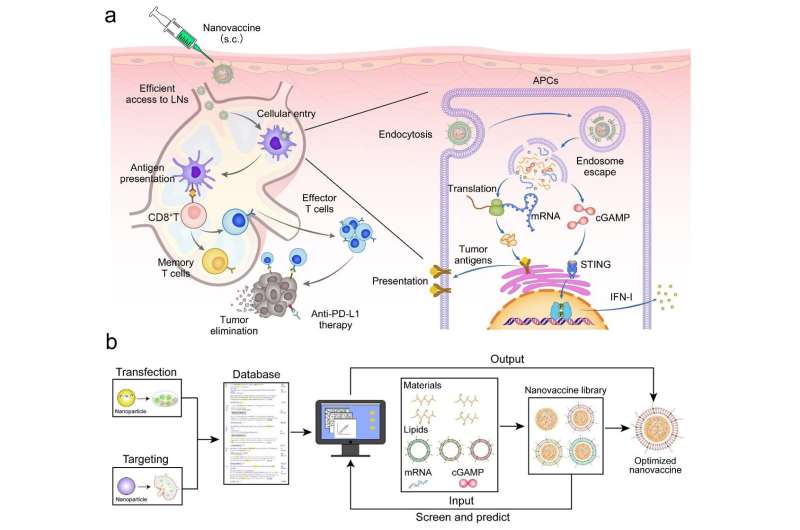
(a) Anionic Lipo-ORG enabled effective access to lymphatics and high accumulation in lymph nodes. Effective cellular entry and endosome escape of mRNA and cGAMP was achieved in DCs and potentiated antigen presentation to T cells. Tumor antigens were presented after the release of mRNA. cGAMP activated STING pathway to trigger IFN-I, which amplified the innate and adaptive immune responses. T cell inflammation and immune memory effect were initiated for tumor elimination, which was further improved when combined with anti-PD-L1 therapy. (b) A brief outlook upon further optimization of nanovaccines for lymph node targeting and efficient delivery through machine learning techniques. Credit: Science China Press
Messenger RNA (mRNA) vaccines are revolutionizing the therapy of cancer. They can be flexibly developed in a short period of time, allowing transient expression of multiple antigens for safe and efficient immunization. A diversity of mRNA vaccines is being explored in clinic to benefit patients with cancer.
However, the translation of mRNA vaccines is still hampered by multistage delivery barriers before initiating strong immunity, including rapid clearance, poor targeting to lymphoid organs and dendritic cells, catalytic hydrolysis and weak capability to pass through phospholipid bilayers. Additionally, vaccination with mRNA alone can barely induce strong immune responses in the absence of adjuvants. It remains challenging to improve cytosolic delivery of mRNA and promote its in vivo vaccination efficacy in combination with adjuvants.
In past decades, a huge number of nanocarriers have been reported to promote transfection efficacy of nucleic acid drugs or deliver drugs to lymph nodes. These studies provide valuable features including size, surface charge, modification, responsiveness, components and cytotoxicity to achieve the goal for lymph nodes drainage or cytosolic access.
Machine learning techniques provide powerful tools for exploring the physicochemical characteristics and biological features of these nanoparticles, and facilitate the design of nanocarriers with high efficiency. Commonly, machine learning models were trained, selected and optimized with high quality and massive datasets from computations and high-throughput experimental data, and in turn guide the rational design, screening and optimization of nanocarriers.
By leveraging existing nanocarriers’ databases, machine learning may provide insights into rational design of nanovaccines with high efficiency.
In a new research article published in the National Science Review, scientists from the Chinese Academy of Sciences and Shanghai Jiao Tong University used machine learning to guide the rationalized design of mRNA nanovaccines. This study identified the key parameters of nanovaccines for efficient delivery of mRNA and cGAMP based on a machine learning model from the Nanocarrier Database.
The mRNA/cGAMP nanocomplexes based on phenylboronic acid grafted polyethyleneimine were prepared and further encapsulated with anionic lipids to obtain the nanovaccine.
(1) The negative surface charge of the nanovaccine reduces the interaction with negatively charged glycosaminoglycans in matrix and improves accumulation in the lymph nodes.
(2) The nanovaccine, after being internalized by the antigen-presenting cells (APCs) in the lymph nodes, promotes the release of mRNA and cGAMP from the endosomes to the cytoplasm, which activates the STING pathway and induces the presentation of tumor antigens.
(3) The activation of STING pathway promotes the release of IFN-I, which activates T cell immune response to kill tumor cells and inhibit tumor growth and metastasis. Compared with the mRNA alone, the therapeutic strategy based on this nanovaccine demonstrated stronger anti-tumor effects in melanoma and colorectal cancer models.
The paper is published in the journal National Science Review.
More information:
Lei Zhou et al, STING agonist-boosted mRNA immunization via intelligent design of nanovaccines for enhancing cancer immunotherapy, National Science Review (2023). DOI: 10.1093/nsr/nwad214
Citation:
Rational design of mRNA nanovaccine for cancer immunotherapy (2023, October 16)
retrieved 17 October 2023
from https://phys.org/news/2023-10-rational-mrna-nanovaccine-cancer-immunotherapy.html
This document is subject to copyright. Apart from any fair dealing for the purpose of private study or research, no
part may be reproduced without the written permission. The content is provided for information purposes only.
>>> Read full article>>>
Copyright for syndicated content belongs to the linked Source : Phys.org – https://phys.org/news/2023-10-rational-mrna-nanovaccine-cancer-immunotherapy.html
